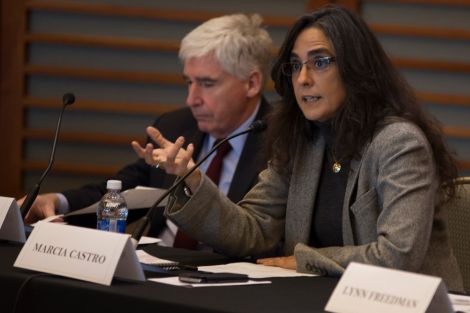Living in the shadows: Health of poor urban women often overlooked

Marcia Castro, associate professor of demography, and panel moderator David Canning, Richard Saltonstall professor of population sciences/ Photo: Sarah Sholes
An elderly woman struggles to find food, clean water, and a toilet in her slum in India. A Brazilian woman, frightened by violence in her poor section of town, refuses to let a public health worker into her house to check for disease-causing mosquitoes. A young homeless mother in Boston needs shelter for herself and her children in a city with one of the highest housing costs in the nation. These examples highlight the struggles that millions of women and girls living in poverty face while living in the shadow of prosperity in the world’s largest cities.
Their health challenges were spotlighted at Harvard T.H. Chan School of Public Health’s 4th Annual State of Global Health Symposium, held March 22, 2017. The event was sponsored by the Department of Global Health and Population and was part of the department’s 2017 Global Health Week.
The world is becoming more urbanized at a record pace—more than half of the world’s population lives in urban areas, a number predicted to rise by more than 60 percent by 2030. This produces both opportunities and challenges for the health of women and girls, said Wafaie Fawzi, chair, Department of Global Health and Population, Karen Emmons, Dean for Academic Affairs, and Ana Langer, director of the School’s Women and Health Initiative, in their opening remarks. While cities generally offer more health services, education, and jobs than rural areas, they said city dwellers are at increased risk of exposure to environmental hazards, violence, and mental health issues.





